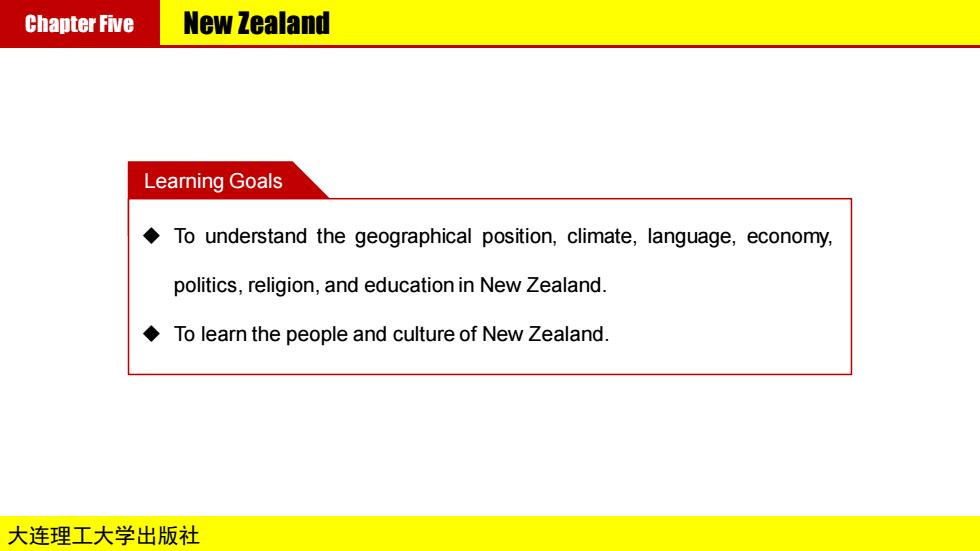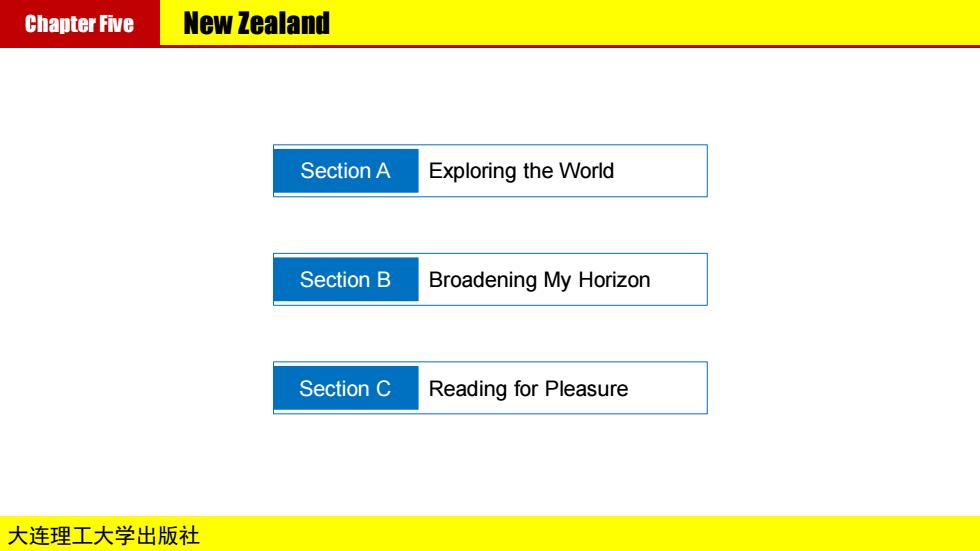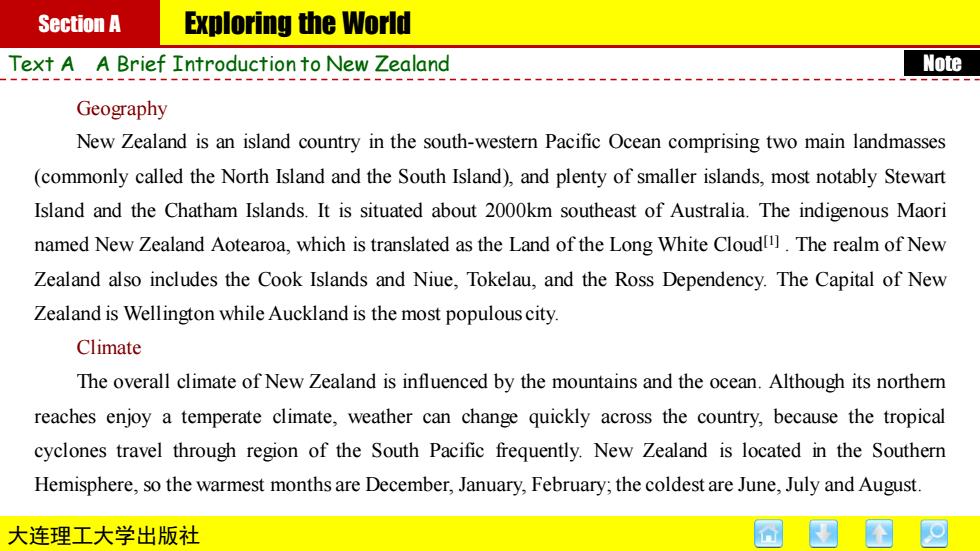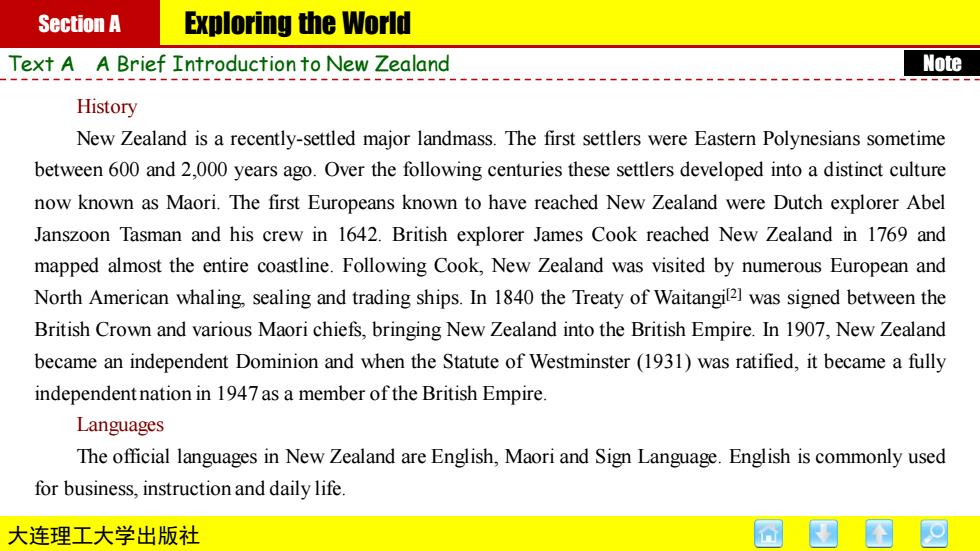
Chapter Five New Zealand Learning Goals ◆ To understand the geographical position,climate,language,economy, politics,religion,and education in New Zealand. To learn the people and culture of New Zealand. 大连理工大学出版社
大连理工大学出版社 Chapter Five New Zealand Learning Goals ◆ To understand the geographical position, climate, language, economy, politics, religion, and education in New Zealand. ◆ To learn the people and culture of New Zealand

Chapter Five New Zealand Section A Exploring the World Section B Broadening My Horizon Section C Reading for Pleasure 大连理工大学出版社
大连理工大学出版社 Chapter Five New Zealand Section A Exploring the World Section B Broadening My Horizon Section C Reading for Pleasure

Section A Exploring the World Leading In What do you know about the following pictures? 出 大连理工大学出版社
大连理工大学出版社 Section A Exploring the World Leading In What do you know about the following pictures?

Section A Exploring the World Text AA Brief Introduction to New Zealand Note Geography New Zealand is an island country in the south-western Pacific Ocean comprising two main landmasses (commonly called the North Island and the South Island),and plenty of smaller islands,most notably Stewart Island and the Chatham Islands.It is situated about 2000km southeast of Australia.The indigenous Maori named New Zealand Aotearoa,which is translated as the Land of the Long White Cloudll.The realm of New Zealand also includes the Cook Islands and Niue,Tokelau,and the Ross Dependency.The Capital of New Zealand is Wellington while Auckland is the most populous city. Climate The overall climate of New Zealand is influenced by the mountains and the ocean.Although its northern reaches enjoy a temperate climate,weather can change quickly across the country,because the tropical cyclones travel through region of the South Pacific frequently.New Zealand is located in the Southern Hemisphere,so the warmest months are December,January,February;the coldest are June,July and August. 大连理工大学出版社
大连理工大学出版社 Section A Exploring the World Text A A Brief Introduction to New Zealand Geography New Zealand is an island country in the south-western Pacific Ocean comprising two main landmasses (commonly called the North Island and the South Island), and plenty of smaller islands, most notably Stewart Island and the Chatham Islands. It is situated about 2000km southeast of Australia. The indigenous Maori named New Zealand Aotearoa, which is translated as the Land of the Long White Cloud[1] . The realm of New Zealand also includes the Cook Islands and Niue, Tokelau, and the Ross Dependency. The Capital of New Zealand is Wellington while Auckland is the most populous city. Climate The overall climate of New Zealand is influenced by the mountains and the ocean. Although its northern reaches enjoy a temperate climate, weather can change quickly across the country, because the tropical cyclones travel through region of the South Pacific frequently. New Zealand is located in the Southern Hemisphere, so the warmest months are December, January, February; the coldest are June, July and August. Note

Section A Exploring the World Text AA Brief Introduction to New Zealand Note History New Zealand is a recently-settled major landmass.The first settlers were Eastern Polynesians sometime between 600 and 2,000 years ago.Over the following centuries these settlers developed into a distinct culture now known as Maori.The first Europeans known to have reached New Zealand were Dutch explorer Abel Janszoon Tasman and his crew in 1642.British explorer James Cook reached New Zealand in 1769 and mapped almost the entire coastline.Following Cook,New Zealand was visited by numerous European and North American whaling,sealing and trading ships.In 1840 the Treaty of Waitangil21 was signed between the British Crown and various Maori chiefs,bringing New Zealand into the British Empire.In 1907,New Zealand became an independent Dominion and when the Statute of Westminster(1931)was ratified,it became a fully independentnation in 1947 as a member of the British Empire. Languages The official languages in New Zealand are English,Maori and Sign Language.English is commonly used for business,instruction and daily life. 大连理工大学出版社
大连理工大学出版社 Section A Exploring the World Text A A Brief Introduction to New Zealand History New Zealand is a recently-settled major landmass. The first settlers were Eastern Polynesians sometime between 600 and 2,000 years ago. Over the following centuries these settlers developed into a distinct culture now known as Maori. The first Europeans known to have reached New Zealand were Dutch explorer Abel Janszoon Tasman and his crew in 1642. British explorer James Cook reached New Zealand in 1769 and mapped almost the entire coastline. Following Cook, New Zealand was visited by numerous European and North American whaling, sealing and trading ships. In 1840 the Treaty of Waitangi[2] was signed between the British Crown and various Maori chiefs, bringing New Zealand into the British Empire. In 1907, New Zealand became an independent Dominion and when the Statute of Westminster (1931) was ratified, it became a fully independent nation in 1947 as a member of the British Empire. Languages The official languages in New Zealand are English, Maori and Sign Language. English is commonly used for business, instruction and daily life. Note